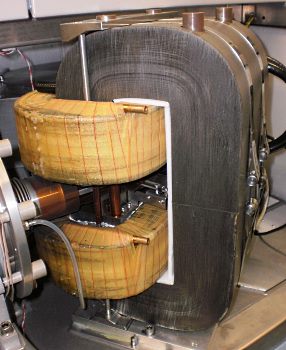property>magnetic permeability
What is Magnetic Permeability?

The magnetic permeability of a material is the degree of magnetization that it receives when it responds linearly to a magnetic field. In Greek, the symbol for magnetic permeability is denoted as μ, which is measured in units of H/m (Henry per meter) or N/A2 (newton per ampere squared). Empty space itself has an electromagnetic permeability value, also known as the magnetic constant, μ0 = 4π.10-7 N/A2
For the purpose of demonstrating a mathematical relationship between μ and some magnetic field B that is influencing a medium of some kind, let’s assume that there is an auxiliary magnetic field H that represents the way this B field influences the organization of magnetic dipoles in our medium. According to the way we have set up situation, the relationship between the fields B, H, and our permeability μ is mathematically defined by the following equation:
B = μH
in the above case, our permeability will be scalar as long as our medium is isotropic. Isotropy refers to a certain organization of the medium that means it is uniform in all directions. Anisotropy is the opposite of isotropy. We are able to use a scalar for permeability if we are working with a second rank tensor for an anisotropic linear medium.
For the most part, magnetic permeability is not constant. Many different local factors will have an influence on permeability, factors such as the frequency of the field applied, temperature, the position within the medium, and humidity. Magnetic permeability can depend on the strength of the magnetic field in nonlinear media. In certain kinds of materials, like ferromagnets, magnetic permeability can get to be quite complex. In those cases, the relationship between the B and H field is both nonlinear and demonstrates some form of hysteresis, or material memory. That is to say the relationship between B and H depends on what has happened to the material in the past.
The relative permeability of a material is the ratio of the permeability of a medium to the permeability of free space, and is mathematically determined by:
μr = μ/μ0
where μ0 is the permeability of free space. One property relating to relative permeability is the magnetic susceptibility of a material, which is the degree to which a material will become magnetized in response to an applied magnetic field. The magnetic susceptibility equation is written as:
χm = μr - 1
Then, for a given magnetic field of strength H, the magnetization of an object is defined as:
M = χmH
where M is magnetization, or magnetic dipole moment per unit volume, which is measured in A/m (ampere per meter). It functions much like a magnetic density such that, given an object of a certain volume, we should be able to calculate the total magnetic dipole moment of the object.
Application
A good magnetic core material must have high permeability.